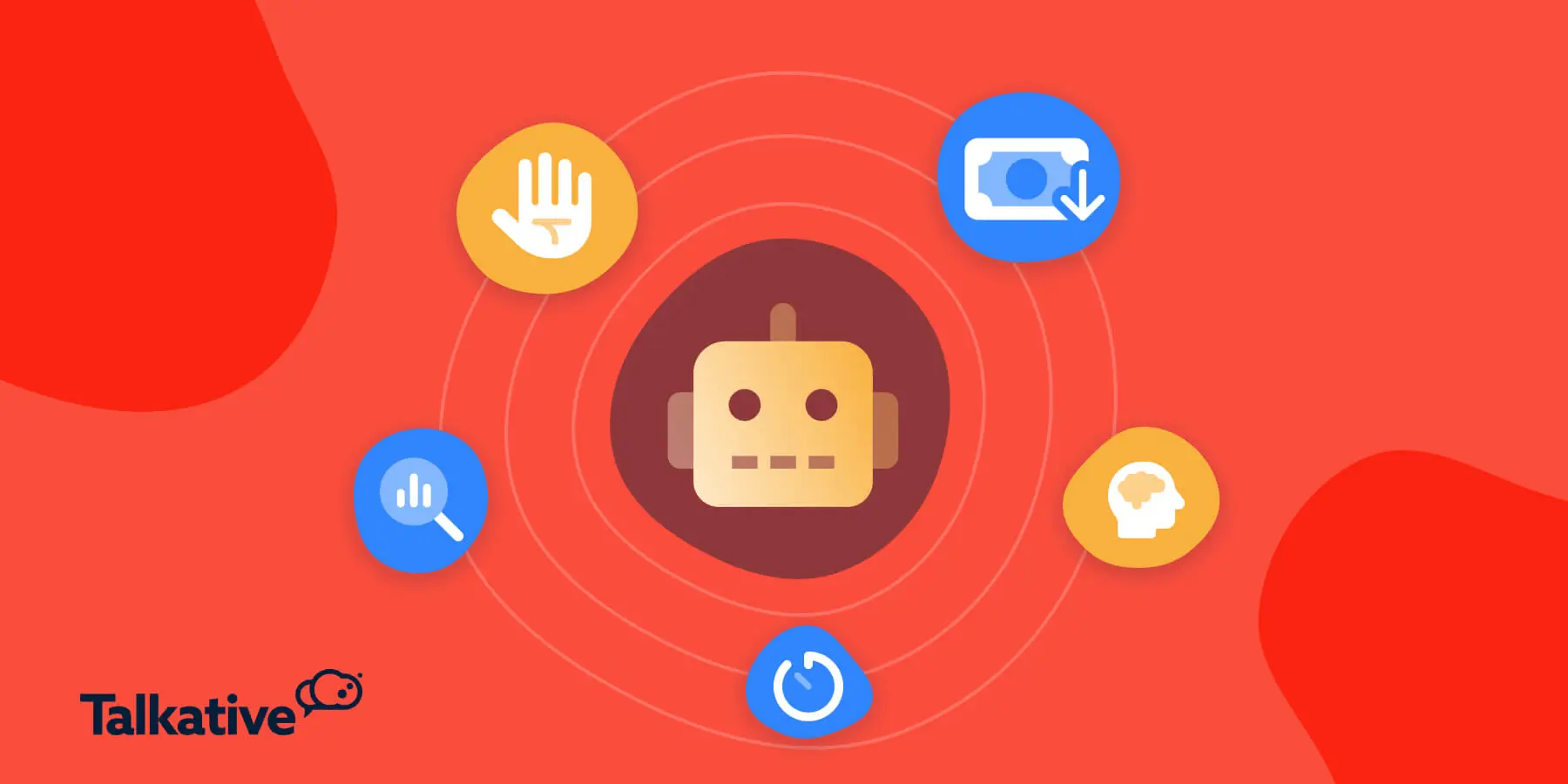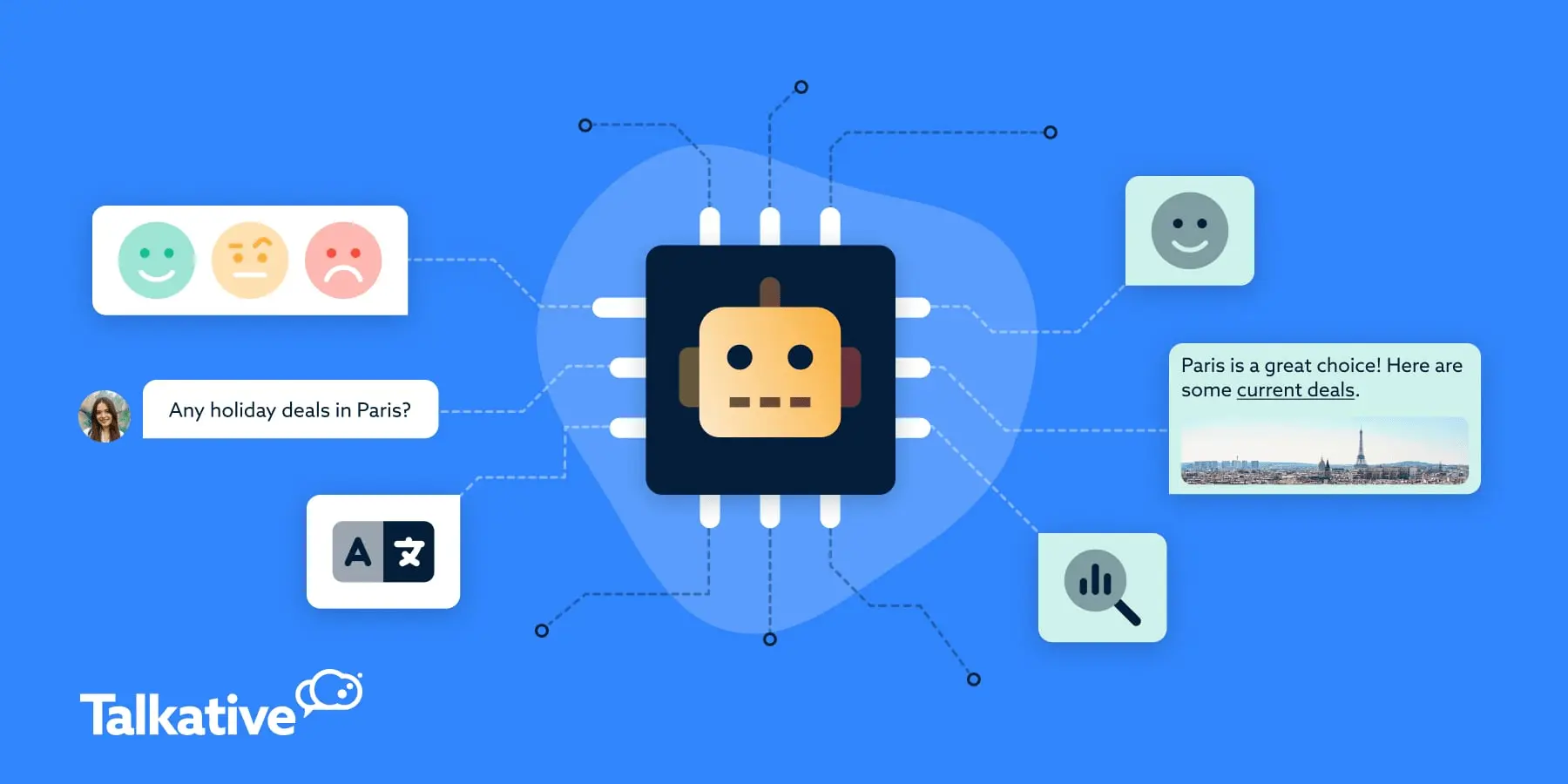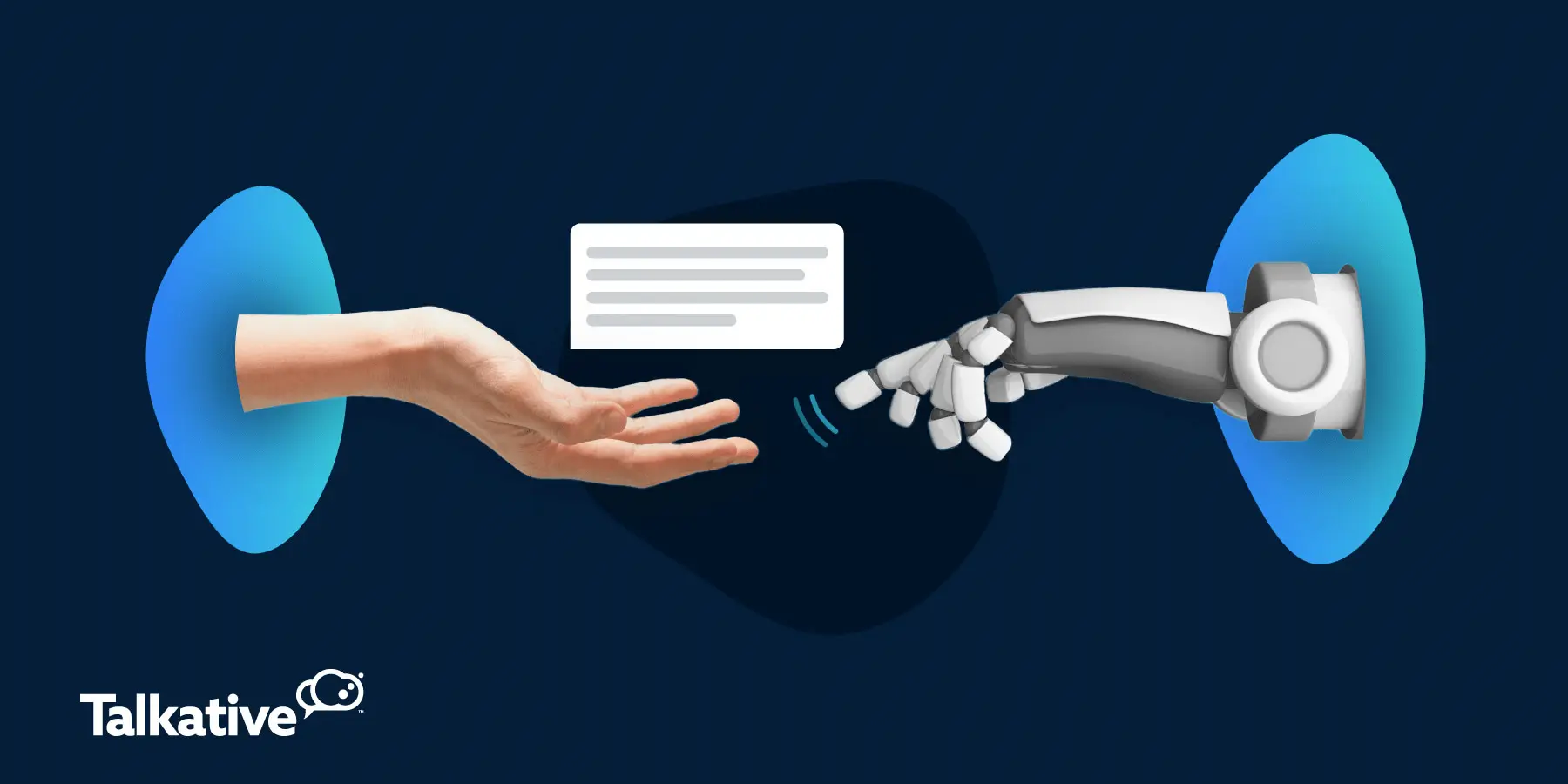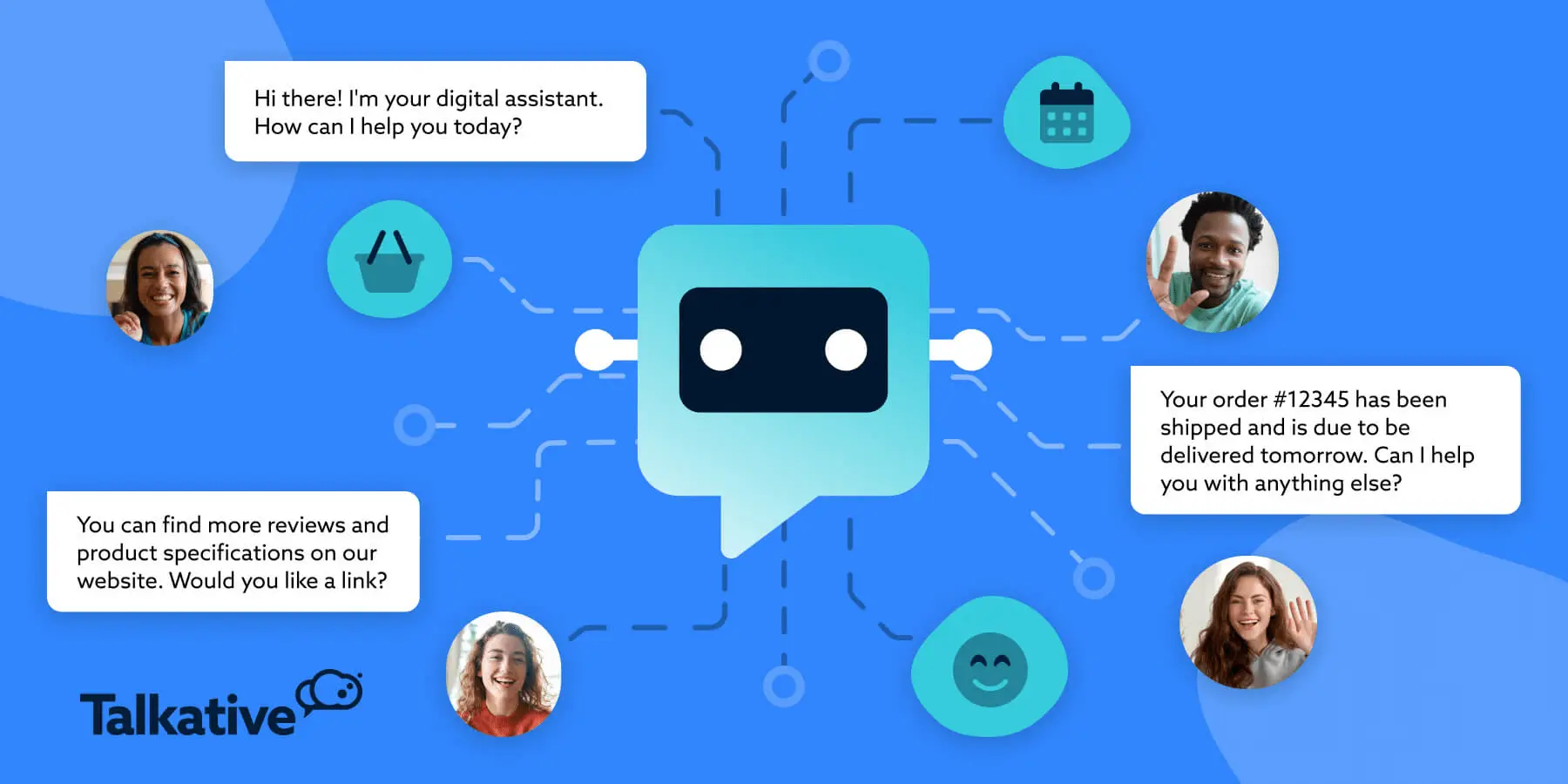It’s getting tougher to meet customer expectations.
They want the best online service possible, and they want it fast.
But how are you supposed to provide fast customer service and support without sacrificing quality?
How is your contact centre team supposed to keep up with the demand?
The answer lies in leveraging customer service chatbots.
In this blog, we'll be taking a deep dive into that very subject. You'll learn:
- What a chatbot is and the benefits of using them alongside human agents
- How chatbots for customer service are built and maintained
- How to improve your organisation's customer service with chatbots
- How to choose the best chatbot
- How to strike a balance between human conversation and automated messages
Let's get started.

What are customer service chatbots?
Customer service chatbots are automated customer support tools.
They can be embedded within an organisation's website, mobile app, or social media pages, providing instant responses to customer inquiries.
A chatbot's primary use is to answer customer questions and provide relevant information to customers without involving a human agent.
With more advanced automation, chatbots can also...
- Take orders and manage online bookings/reservations
- Utilise customer data for lead generation
- Integrate with knowledge bases to act as brand-trained, virtual assistants
- Provide personalisation
- Contribute to sales and lead generation efforts
- Be used as marketing tools

Benefits of using chatbots for customer service
There are many benefits to deploying customer service chatbots - both for your customers and for your support team.
Let's take a look at the benefits for each.
How customer service chatbots benefit the customer experience
These days, chatbots are one of the most efficient digital channels for offering consistent customer service in a proactive way.
When deployed effectively, customers like chatbots because:
- They provide immediate responses
- They provide customers with consistent support, 24/7, 365 days a year
- As a self-service tool, they save time by limiting the need for users to get in touch with a live chat agent
- They can assist with many functions, streamlining the digital journey and customer service processes
These pros contribute to increased customer satisfaction and a better customer experience - both of which cultivate better customer relationships.

How customer service chatbots benefit your support team
When they’re deployed and used effectively, customer service chatbots can yield significant benefits for businesses and customers, including:
- 24/7 suppot: Unlike human agents, chatbots can be available 24/7, ready to assist customers at any time of day or night. This is particularly valuable for international brands serving customers across various countries and time zones.
- Improved efficiency: Chatbots improve efficiency by automating customer service tasks and interactions, thereby lessening the demand on your customer service agents and other contact channels. Case in point, virtual assistant bots have been found to reduce query volume by up to 70% across voice/video calls, live chat, and email.
- Speed: We all know that consumers love fast and efficient service. Chatbots excel at providing this with accelerated response times, replying to users three times faster than human agents on average.
- Customer self-service: Chatbots offer a convenient and easy way for customers to access self-service, enabling them to resolve many queries/issues independently. This boosts customer satisfaction by catering to the 81% of consumers who wish businesses would offer more self-service options. It also decreases the number of cases requiring human intervention, effectively reducing workloads for your customer service team.
- Increased sales: The role of a chatbot isn’t just automated customer support - bots can also contribute to increased conversions and lead generation. Some business leaders have reported a 67% increase in sales through chatbots, and 55% of companies experience an increase in high-quality leads after deploying an AI virtual agent.
- Reduced costs: By automating tasks and customer interactions, chatbots can slash operational costs for businesses. In fact, bots can fully automate up to 80% of routine queries, reducing support costs by around 30%. They’re also a far more cost-effective solution for scalability in comparison to hiring additional customer service reps.

How do customer service chatbots work?
Not all chatbots for customer service are made equal.
There are various approaches to chatbot design, each with its unique working mechanisms and capabilities.
Whether you're looking to build your own chatbot or implement a customer service solution, there are three main types of chatbot that you could deploy as customer service tools.
Below, we'll provide an overview of these types and how different chatbots work.
1. Rule-based chatbots
Rule-base (a.k.a. "decision tree" chatbots) are the most basic type of bot design.
They operate using a predefined set of rules and conditions, following a decision tree framework.
These bots excel at automating structured and repetitive tasks (e.g. answering frequently answered questions) because of their consistency and simplicity.
However, their lack of flexibility and adaptability means they can’t handle unforeseen or novel inputs.
Moreover, rule-based chatbots for customer service can struggle to understand and replicate natural human language, often leading to a frustrating or "bot-like" user experience.
This also means that scaling a rule-based bot to do more than answer common customer service inquiries is challenging.

2. AI-powered chatbots
Advancements in artificial intelligence have resulted in a new generation of chatbots for customer service.
AI-powered chatbot solutions act more like human customer service agents.
They work much better in two-way customer interactions, offering a more fluid conversational experience.
Instead of solely relying on scripted responses, an AI chatbot uses technologies like:
- Conversational AI
- Natural Language Processing (NLP) & Natural Language Understanding (NLU)
- Generative AI
- Machine Learning
- Large Language Models (LLMs)
These applications of artificial intelligence make AI customer service chatbots far more advanced, capable of interpreting and answering a wider range of customer queries.
This means that an AI chatbot can deal with more queries, more efficiently, and in a more humanised way.

2. Hybrid chatbots
Hybrid models work by integrating rule-based and AI-driven techniques to get the best of both worlds.
This creates a flexible solution capable of automating both routine tasks and more complex queries.
These bots use pre-established rules/scripts for specific functions while also integrating AI to expand their functionality and language comprehension.
For example, a hybrid system might answer FAQs using a decision tree framework but switch to AI when confronted with more intricate issues or queries.
This versatile architecture means that you can pick and choose elements from different types of bot design.

How do you create a chatbot?
As we've touched on above, chatbots for customer service can either be powered by:
- A framework of prepared scripted answers that answer FAQs,
- Artificial intelligence technologies, or
- A combination of the two.
Creating rule-based bots
Pre-scripted chatbots need to be provided with decision tree routing to communicate with customers effectively.
That way, when a customer asks a question, they can use the decision tree to relay the appropriate answers.
Creating AI bots
In contrast, AI chatbots are 'trained' by integrating with your knowledge base content.
They can also learn from your customers over time by recalling past interactions and analysing messages to determine sentiment and intent.
How to choose a customer support chatbot
Choosing the right chatbot solution for your business is an important process.
It's important to consider your specific business needs to help make this decision.
For example, a small business or start-up will have very different chatbot needs compared to an international brand looking for an enterprise chatbot solution.
When deciding on a chatbot for your business, you first need to determine its primary purpose.
For example, will it offer simple FAQ support or more human-like interactions?
Secondly, you need to decide what other digital channels you'll use to compliment your bot. Take web chat, for example.
Either way, to find out what kind of chatbot you need, ask yourself the following questions.
Key chatbot considerations
- What types of customers will be using your chatbot?
- What issues most commonly arise during customer interactions?
- Do you want to use your chatbot to simply direct customers to the correct department, or do you want them to handle entire conversations with artificial intelligence?
- What kind of analytics dashboard would your customer service teams require?
- On which devices or digital channels will you offer your chatbot?
- What is your overall goal when installing a chatbot? For example, will you be limiting web chat queues and increasing efficiency?
- Are there any limitations of chatbots you might need to mitigate for your specific use cases?
- What is your budget for chatbot implementation?
Keeping these kinds of questions at the forefront of your mind will help you find a customer service chatbot that both improves the customer experience and meets your needs/requirements.

How to improve customer service with chatbots
These days, chatbots are an essential part of any customer service solution.
In fact, 40% of millennial customers say they interact with chatbots every day.
Still, that doesn't mean every business uses them to their best ability.
When businesses fail to use chatbots correctly, it can cause user tension and ruin the customer experience.
That said, this doesn't mean customer support chatbots are the wrong choice for your business.
Far from it, in fact.
It's more that some organisations don't design their chatbots in line with their customers' needs.
To make sure you can offer the best customer support and achieve your customer service goals, you'll need to take into account two main areas.
1. Purpose
As we've already seen, deciding on your chatbot's purpose is hugely important.
Overestimating your chatbot's abilities is a sure-fire way to annoy its users.
Customers won't be satisfied if they encounter a chatbot that appears to be more advanced than it is.
It's the same case if you present your chatbot as a real human.
When your customers discover that they're dealing with a bot, they're going to realize you've broken their trust.
Again, this is not a good look.
So, make sure your chatbot’s purpose is clearly defined, both for yourself, and your customers.

2. Personality
Unlike humans, chatbots don't come with a personality of their own.
It's another aspect you're going to have to think about before you deploy.
An excellent tip for deciding on your chatbot's personality is to consider how you want to broadcast your chatbot’s chosen purpose.
For example, say you want to offer a scripted bot to deflect customers from your live chat agents.
If this bot only answers the simplest of questions, the bot doesn't need a huge personality.
In this scenario, it's best to give it a generic, 'bot-like’ personality instead.
Your customers might get irritated if you code a simple bot with too much of a presence when it only answers scripted questions.
Again, your customers might think your bot is more powerful than it really is.
That said, chatbots don't always need to be boring.
Suppose your brand has a fun image and tone, and your bot uses artificial intelligence to converse.
In that case, a more fun personality could be a great move for an improved customer experience.
Just remember to create a personality that best speaks to your target audience.
With 48% of customers stating that fast resolution times are more important than quirky personalities, it’s proof that a succinct chatbot interaction isn't off-putting.

Chatbots vs live chat agents: Which is best?
Research shows that by 2022, 75-90% of customer queries will be handled entirely by chatbots.
Even so, the best approach to deploying customer service chatbots is to use them alongside a dedicated support team.
Not only can human agents solve far more complicated queries, they can also assist your customers on multiple channels like web chat and video chat.
After all, how do you think your customers will feel if they get into a knot during a chatbot interaction?
Even if the chatbot does supply quick answers, users will only get annoyed if the responses they receive don't make any sense.
This scenario will hardly improve engagement.
So, if your chatbot will serve as your primary point of contact, it might be best to adopt a solution that can understand when a user is getting annoyed or confused.
That way, they can escalate the interaction to another channel where a human agent can efficiently take over.

Industry examples of customer service chatbots
Here are a few industry use case examples, demonstrating what's possible with your customer service chatbot.
Financial services: HSBC
High street banks don't often have the best reputation for customer service.
They can be infamous for long phone queues and complicated online processes.
To rise above their competitors, HSBC recently launched a chatbot to improve their online response times and functionality.
Using AI-based technology, HSBC’s chatbot can now offer online policy information in a fast and customer-friendly manner.
Fast food: Dominos
Domino's launched their chatbot 'Dom' back in 2017.
First offered through Facebook Messenger, this customer service chatbot is now available through various contact channels.
With this chatbot, customers order food and keep track of their orders in a fun and engaging way.
For more on Dom and the customer engagement success it's brought Domino's, check out our article on the best ecommerce chatbots.
Retail: Nike
Nike's 'Stylebot' is another customer service chatbot that got its start on Facebook Messenger.
Nike's bot is proof that a great imagination can help to improve the online customer experience.
With their chatbot, users can browse outfits based on their personality, not just their preferences.
It's proved a creative way to offer fast and automated customer service while increasing convenience, engagement, and satisfaction.

Choosing the best customer support chatbot
Now that we've outlined how a customer service chatbot can work for various businesses, you might be wondering which chatbot providers offer the best solution.
To help you decide, we've outlined a few of the key names you should explore.
Talkative
You might've seen it coming, but we'd be remiss not to highlight Talkative's own customer service chatbot in this discussion.
With our scalable and flexible GenAI chatbot solution, you can:
- Choose between an intent/rule-based system, AI, or a combined approach (an AI chatbot with rule-based fall-back for maximum efficiency).
- Integrate a chatbot with your own AI knowledge bases to create virtual assistants that are experts in your brand, products, and services.
- Meet and serve customers across your website, app, and messaging channels.
- Seamlessly escalate to human agents when needed.
- Leverage AI-driven analytics and reporting.
- Build multiple chatbots in-house (if you prefer to take the wheel with bot design).
- Automate customer-specific queries with chatbot fulfilment.
Whether you need a standalone deployment or integration with big names like Salesforce, Mitel, and Microsoft, we've got you covered.
Add a no-code building experience into the mix, and you'll be able to deploy your customer service chatbot with ease.

Zendesk
When it comes to customer service chatbots, Zendesk is a big name for a reason.
Adopting their solution will mean your business is amongst some colossal brand names too.
Much like Talkative's solution, you can use Zendesk's customer service chatbot to answer customer queries at any time, night or day.
However, their basic package only allows you to offer 50 AI answers to your customers a month - so make sure you properly check their pricing tiers for your needs.

Freshworks
Freshworks is another excellent option.
Much like Talkative's customer service chatbot, their model enables you to qualify leads on your website and answer visitor questions, all based on user behaviour.
It means you can help boost both your sales and customer service teams, all thanks to intelligent automation.
Freshworks is traditionally known as a helpdesk software provider too, so if a chatbot isn't your primary concern, it's a great choice.

FAQs about customer service chatbots
To round off our discussion on chatbots, here are the answers to your most frequently asked questions.
When were chatbots invented?
The first 'chatterbot', ELIZA, was invented by professor Joseph Weizenbaum in 1966.
Where do chatbots get their information?
Chatbots retrieve information from a company's knowledge database. They can also use AI technology like natural language processing (NLP) and machine learning to answer customer questions.
Do customers actually like chatbots?
They do - however, a poorly programmed chatbot can cause huge customer perception issues.
It's the same with any other self-service tool - even FAQ pages can sour the customer experience if they aren't written helpfully.
Should you always keep chatbots on?
It's up to you. Some companies only turn on their chatbot during out of office hours. Some keep them on 24/7.
It all comes down to your needs.
Can chatbots provide multilingual support?
Yes - Talkative's chatbot uses our real-time translation technology, meaning it can interact in over a 100 languages.
Can you connect chatbots to other channels?
You can - chatbots work great in conjunction with live chat.
It enables bots to escalate interactions when they don't understand a customer's query.
How do chatbots escalate to human agents?
Chatbots can be programmed to escalate customer inquiries when they don't understand the user's requests or when they type a keyword of your choosing, e.g. 'speak to human'.
Is it easy to create your own chatbot?
Building a chatbot requires a large amount of coding experience.
In contrast, chatbots can be simple to implement with customer service platforms like Talkative.
Can you design how your chatbot looks?
You can - thanks to Talkative's widget builder, you can create your chatbot in line with your brand and website.
What security concerns are there with bots?
If a customer service chatbot collects data, the biggest concern for businesses is security and customer privacy.
It's why our customers choose Talkative - they know all our contact channels are security compliant, valuing privacy and safety above all else.
What name should you give your chatbot?
Depending on your brand, you might want to opt for a serious name or something more fun.
Either way, it's best to make it evident that customers are speaking to a bot.

The takeaway
As an automated customer service tool, chatbots are the ideal solution for increasing efficiency while reducing pressure on contact agents.
When they're deployed and leveraged effectively, they can also impove the customer experience by streamlining support.
That said, it’s important you choose the right chatbot software for your brand.
That’s where Talkative comes in.
As we've explored, our advanced and versatile chatbot solution can be tailored to fit your specific business needs and objectives.
In addition to chatbots and AI solutions, we offer a suite of customer contact channels and capabilities - including live chat, web calling, video chat, messaging, and more.
Book a demo with Talkative today, and check out our interactive product tour.



